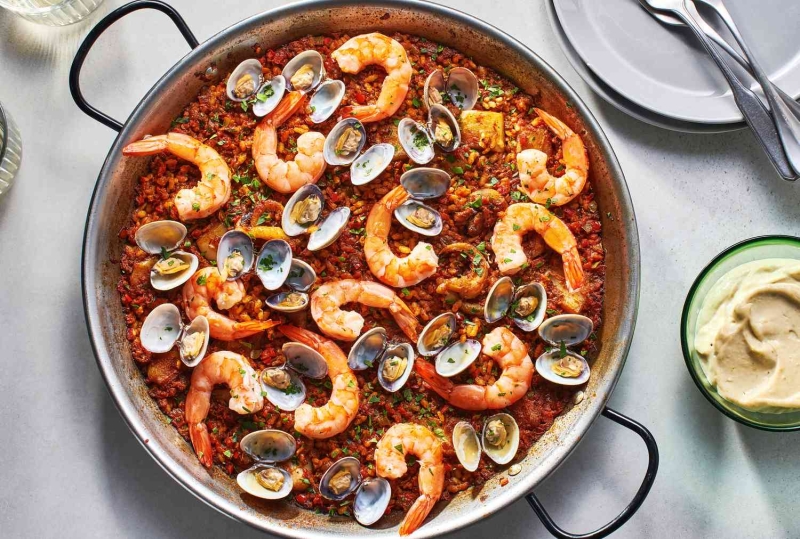Everything you didn’t know about paella
Prep: 30 mins
Cook: 95 mins
Resting Time: 10 mins
Total: 2 hrs 15 mins
Servings: 4 servings
Yield: 6 cups
I celebrated my 15th birthday with my dad on a road trip eating our way through Europe, and two of the places we spent the most time were Madrid and Barcelona. Simply put, Spain stole my teenage heart. So much that by the age of 19 I moved to Barcelona and fell madly in love, but that’s a story for another recipe. During my time there I quickly learned that inside the kitchens of Spanish yayas, they do not make paellas daily; that saffron and lemon wedges are not a must on all paellas; and that they did not like those “all yellow paellas,” also known as tourist trap paellas.
Paella: The Origin Story
Paella is to Spain what barbecues mean for so many of us on this side of the Atlantic. At its core paella means a special occasion or family and friends gathering around the table on Sundays. To say there is a simple way to define paella would be impossible so let’s have a paella heart-to-heart. Paella-like dishes have been documented as far back as the time of the Romans and are said to have been brought to Spain by Muslim North Africans, as they brought rice with them. But historians have agreed that paella as we know it is rooted in Valencia, Spain. Hence the paella Valenciana is the one and only paella by definition.
The Only Recognized Paella is the Paella Valenciana
A paella is a type of pan, period. However, throughout the years, outside of Spain any rice dish cooked in a paella pan has been called a paella. Meanwhile, the “original” paella has been recognized and baptized as the Valenciana or Paella Valenciana. The official list of paella Valenciana ingredients is protected by a “Denominación de Origen.” This is not an easy thing to achieve.
“Denominación de Origen” grants a certification for certain products produced in the region of their origin, in the traditional manner, using specific ingredients. Although rice is the one dish mainly cooked in the paella pan, if it’s not a paella Valenciana made in Spain it is simply a rice dish. Yes, even if you only change the protein or flavor of the broth. If it is not a paella Valenciana, it is not a “paella” at all. There is a saying in Valencia that “there is a difference between paella, and rice mixed with things.”
What Are the Main Types of Paella?
Paella Valenciana is the only recognized paella. Other paellas in Spain must be referred to as "paella de…" modified with the name of the main protein.
The Official List of Recognized Ingredients in Paella Valenciana
- Olive oil
- Chicken
- Rabbit
- Flat Beans (“Coconut Bean” or “Ferraura” or “Bajoqueta”)
- Garrofe bean (“Garrofó”)
- Tomato
- Water
- Salt
- Saffron
- Rice grown in Valencia (Bomba, Calasparra, or Valencia rice)
There are a few optional accepted ingredients in an authentic paella Valenciana, including duck, artichokes, and snails, but all paellas Valencianas must contain the ten bulleted ingredients above.
The Evolution of Paella
While the paella Valenciana and its humble origins have been adored and almost revered in so many regions throughout Spain (and governed by very strict guidelines—there’s no wiggle room). "Paella" as a more general type of dish has recently seen a surge in creativity. Nowadays, there are as many “paella” combinations as toppings are for pizza.
As with many beloved dishes with humble beginnings, over the past five-plus years paella has begun to break away from tradition and is now being made with a rainbow of ingredients. Any combination is welcomed nowadays: chicken wing paella, surf and turf paella with longaniza and crayfish (a favorite in Catalonia); Galician steak paella; vegetarian paella; and my favorite, paella with cigala (Mediterranean slipper lobster).
What is the Most Important Ingredient in Paella?
A great-tasting homemade stock or broth and Bomba rice are the secrets to any good paella.
In this recipe you make a concentrated broth from shrimp shells and aromatics. The broth is fortified with pimentón and tomato paste. For a well-seasoned paella, the broth itself should be pleasantly salty.
Bomba Rice: The Key to Paella
We cannot talk about paella without talking about Bomba rice. Bomba rice is labor intensive to grow and is only grown in the cold wetlands of Calasparra in Murcia near Valencia. Bomba translates to “bomb,” and it holds true to its name. When you eat a good paella each grain really explodes with flavor. Bomba rice is drier than other rice. It has a thick starchy center that you will see when you toast the rice.
Bomba rice's magic power is that it can absorb up to three times its volume of liquid without getting mushy. When cooked, it only expands in width and not in length as other grains of rice, and it resists overcooking. This quality is particularly great for flavor because you will almost never taste a mushy paella.
When you overcook a long grain rice such as jasmine or basmati the rice breaks open, releasing starch and becoming mushy. Even when overcooked this will not happen to Bomba rice. Bomba rice is an important if not the most important ingredient in paella because paella should never be sticky and it cooks very loose—so loose that each grain is distinct as you eat a spoonful of paella or arroz. This is a key characteristic of any paella or rice dish in Spain.
In Search of Socarrat
As we have learned, paella has different layers to it, and a real paella nerd knows about the socarrat, the crusty layer of rice on the bottom of the pan. Socarrat equals time and attention. You have to work for it just a little bit harder to achieve the slightly toasted part of the rice on the bottom of the pan (without burning it) that gives paella that characteristic caramelized flavor and pleasant bite on the palate. You simply cannot walk away when doing this part of paella and it is worth it.
We are living in a time when paellas are undergoing rapid evolution. While there are other rice dishes eaten and deeply loved throughout Spain, paella was, is, and will be a staple dish on every corner in Spain whether it’s made with chicken, longaniza, or cuttlefish; topped with a ribeye steak or pork belly; or the grand Valenciana. Paella is one of those dishes that continues to push culture forward and keep our hearts and bellies full.
Recipe Tips
- For a “homestyle” paella, you can sauté the shrimp along with the cuttlefish and then leave them in for the entire cooking time rather than arranging them on top towards the end of cooking.
- Traditionally, alioli was made just with olive oil, eggs, and garlic in a mortar. But it is important to note that in Spain what they call olive oil is what we know as blended oil. This normally blends olive oil and a neutral oil, also known as a 04-grade oil. 100% olive oil or even extra-virgin oil (which should never be used for alioli) is too powerful and its flavor will overtake everything else. It will even make the alioli a bit bitter.
- If you can't find cuttlefish (they are available in the freezer section of most Asian supermarkets, like H Mart or 99 Ranch), you can substitute more shrimp and/or clams, use octopus or squid instead, or even use a white fish like rockfish, cod, red snapper, or halibut.
- In this recipe the clams are cooked separately to ensure that they do not get overcooked. However, if desired you can arrange the clams on top of the paella at the same time as the shrimp and cook them until they open.
- Paella is all about three things: the rice, good protein, and the broth. Get good fresh protein to ensure great flavor. Whenever possible, Bomba rice is the way to go when making paella. Finally, always, always boil your broth and add hot broth to cook your paella.
- You have to watch this dish closely as it cooks, especially if you are hoping to get the coveted socarrat. Staying close and being what I call “the flame keeper” is an important job when making paella. If it’s not boiling enough, adjust the heat until you find that sweet spot.
- Serve paella by itself or with a simple salad and a dry white wine like Txacoli or a cold beer.
«This is a wonderful, highly riffable paella recipe. The homemade broth is key to the complex flavor of the dish, as is the beautifully smoky pimentón. I love that it’s so easy to swap in different proteins. I couldn’t find clams, so I substituted mussels and that worked perfectly. I plan to try chicken and shrimp next time (there will be a next time!).» —Megan Scott
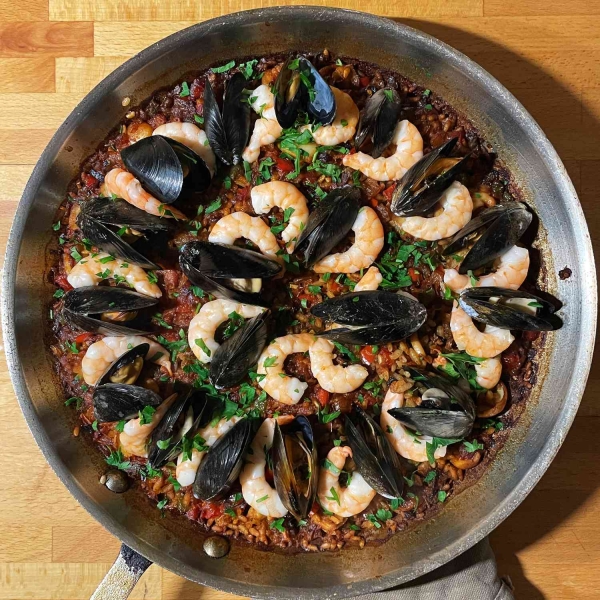
A Note From Our Recipe Tester
Ingredients
For the Shrimp Broth
-
1 pound jumbo shell-on shrimp
-
3 tablespoons extra-virgin olive oil
-
1 shallot, peeled and roughly chopped
-
1 medium yellow onion, peeled and roughly chopped
-
1 carrot, roughly chopped
-
2 celery ribs, roughly chopped
-
1 tablespoon tomato paste
-
2 teaspoons pimentón dulce (smoked sweet Spanish paprika)
-
1/4 cup dry white wine
-
4 cups cold water
-
4 black peppercorns
-
5 sprigs fresh thyme
-
1 bay leaf
-
2 cloves garlic, peeled and smashed
-
Fine salt to taste
For the Alioli
-
1 large egg
-
3 cloves garlic
-
1 shishito pepper (or substitute your favorite small green pepper), stemmed and sautéed just enough to soften, optional
-
1/4 teaspoon fine salt
-
1 cup grapeseed or other neutral oil
For the Paella
-
4 tablespoons extra-virgin olive oil, divided
-
1 medium yellow onion, finely diced
-
1/2 red bell pepper, seeded and finely diced
-
1/2 green bell pepper, seeded and finely diced
-
3 cloves garlic, minced
-
2 Roma tomatoes, seeded and finely diced
-
1 1/2 tablespoons pimentón dulce (smoked sweet Spanish paprika)
-
1/2 teaspoon fine salt
-
1/2 teaspoon ground black pepper
-
1/2 pound cuttlefish, bodies cut into medium dice and tentacles halved
-
1 cup (1/2 pound) Bomba rice
-
1/2 cup dry white wine
-
1/2 pound small clams, scrubbed
-
1/2 cup loosely packed fresh parsley leaves, minced (save the stems)
Steps to Make It
Make the Broth
-
Gather the ingredients.
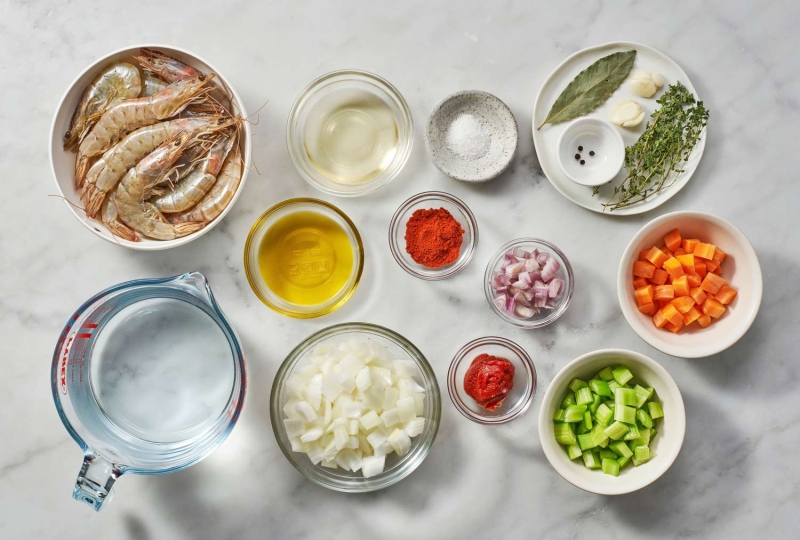
-
Peel the shrimp and save the shells. Devein and refrigerate the shrimp (these will be used when making the paella) while you make the broth.

-
Heat the olive oil in a large saucepan over medium heat. Add the shrimp shells and sauté until they are bright pink and aromatic, about 3 minutes.
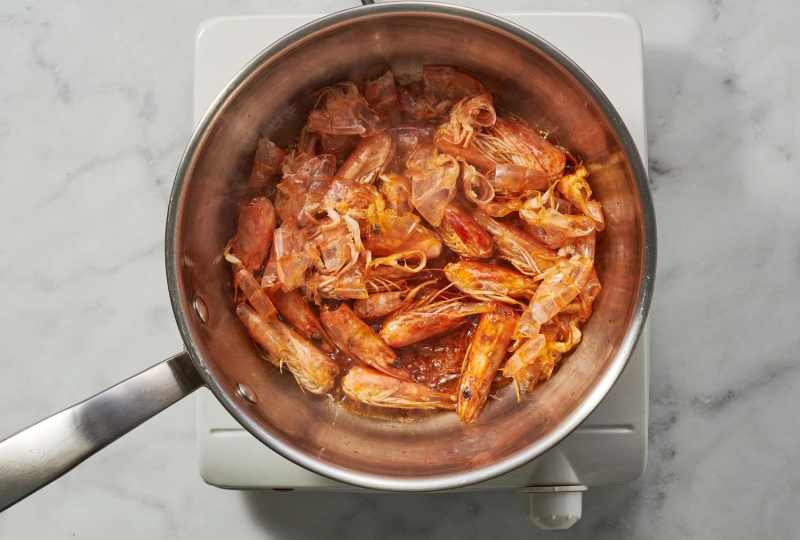
-
Add the shallot, onion, carrot, and celery and sauté until the onion is translucent, 8 to 10 minutes.
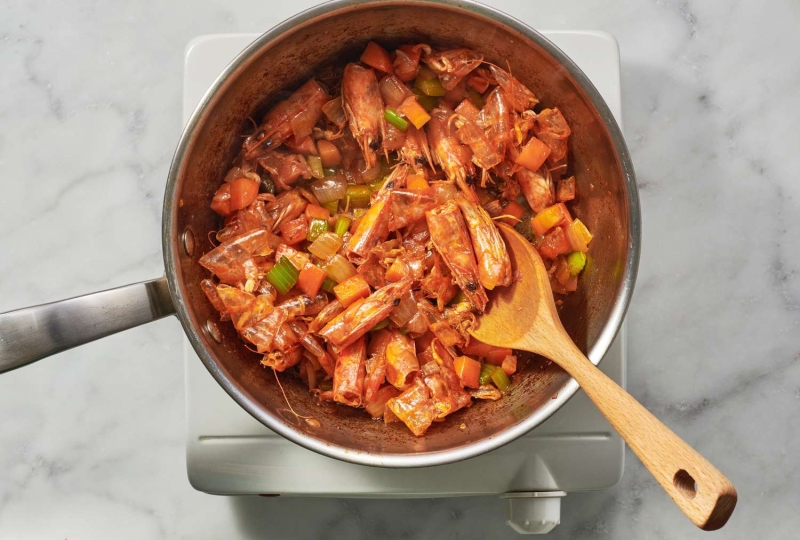
-
Add the tomato paste and pimentón and stir well until the ingredients are incorporated.
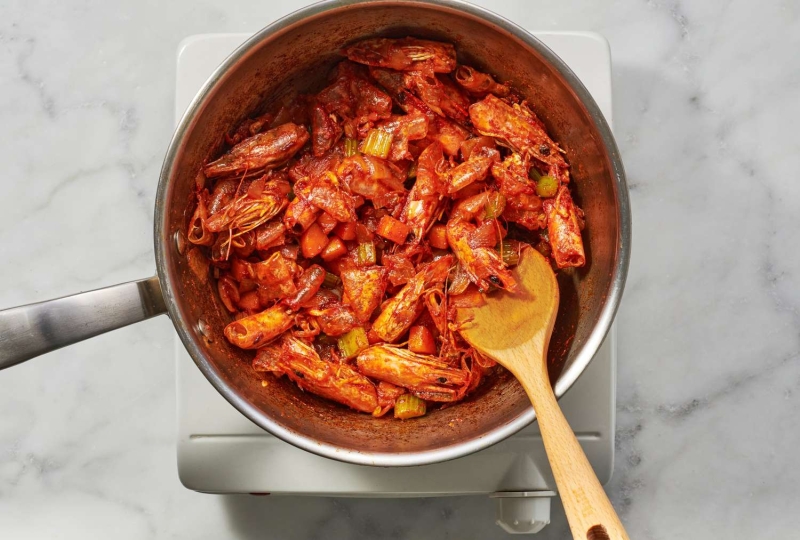
-
Add the white wine and scrape up all the brown bits on the bottom of the pan with a spoon. Cook for 3 to 4 minutes or until the wine has cooked off.
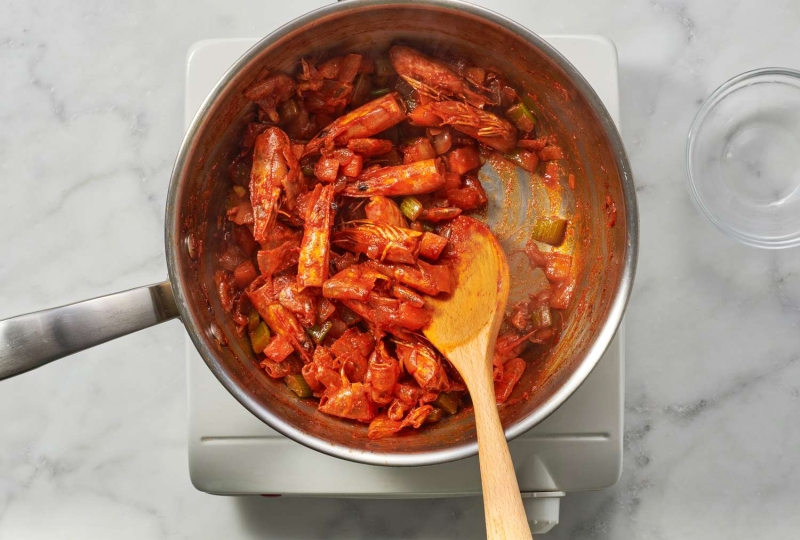
-
Add the water, give it a good stir, and bring to a simmer. Skim off any foam or scum that rises to the top and let simmer uncovered for 10 minutes. You should see bubbles on the edges of the pot.
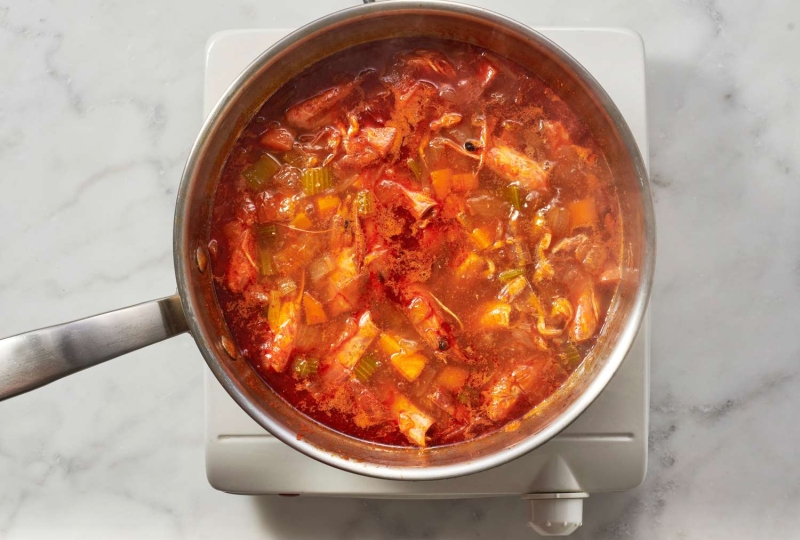
-
After 10 minutes, add the peppercorns, thyme, bay leaf, and garlic and season lightly with salt. Let simmer for another 10 minutes. The broth will reduce by about 1 inch.
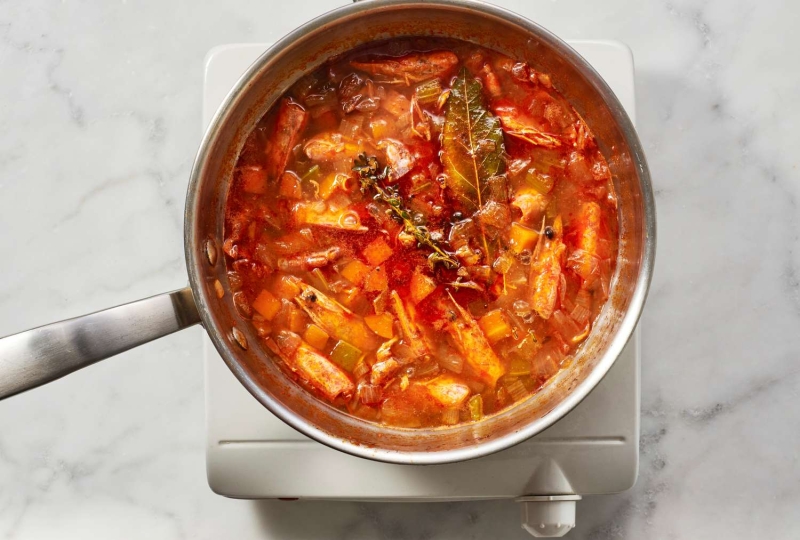
-
Strain the broth through a fine-mesh strainer and use immediately or cool completely, transfer to an airtight container, and refrigerate for up to 72 hours.
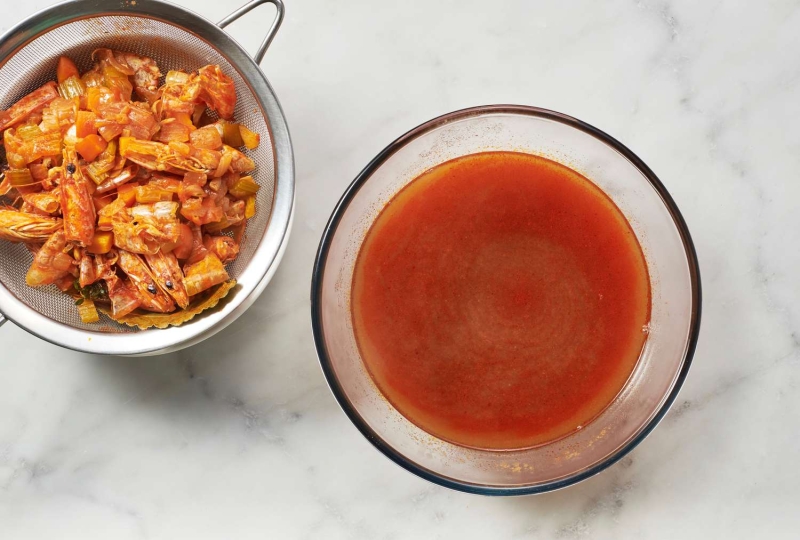
Make the Alioli
-
Gather the ingredients.
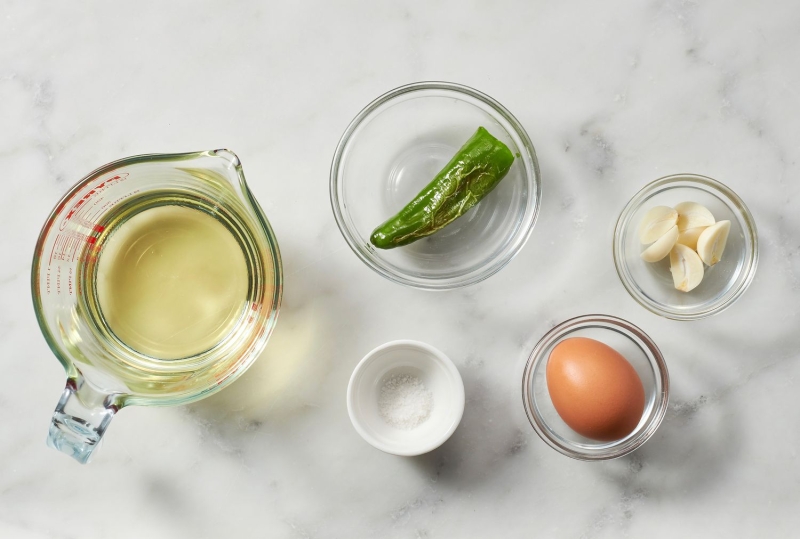
-
Add the egg, garlic, pepper (if using), salt, and oil to a blending cup (the tall cup that comes with your immersion blender).

-
Place your immersion blender in the blending cup so it touches the bottom. Turn the blender on high speed.
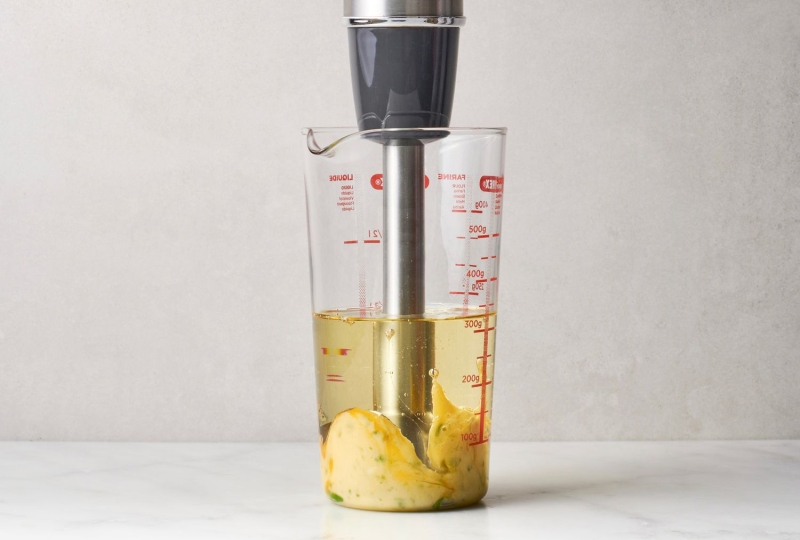
-
Once you see the mixture thickening at the bottom, lift the immersion blender up slowly to continue to emulsify the oil and egg into a mayonnaise-like texture. This all happens in less than a minute. Taste for salt and season to your liking. Keep in the refrigerator for up to 2 days.
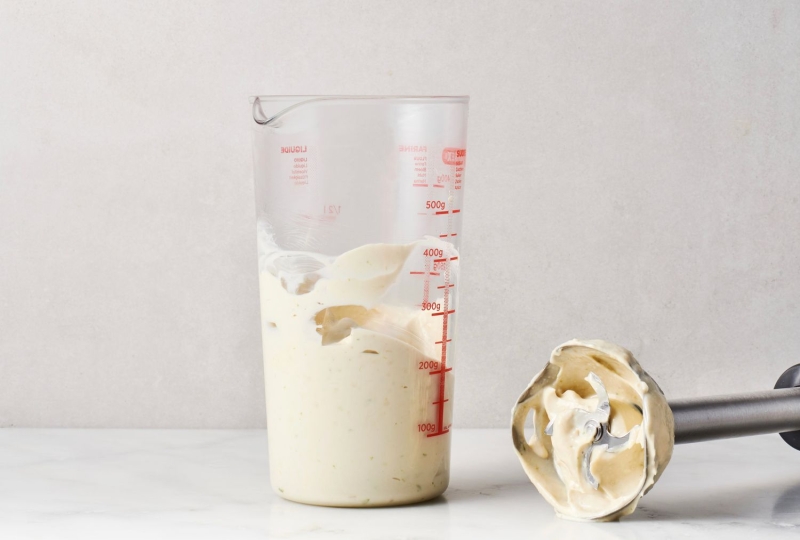
Make the Paella
-
Gather the ingredients.
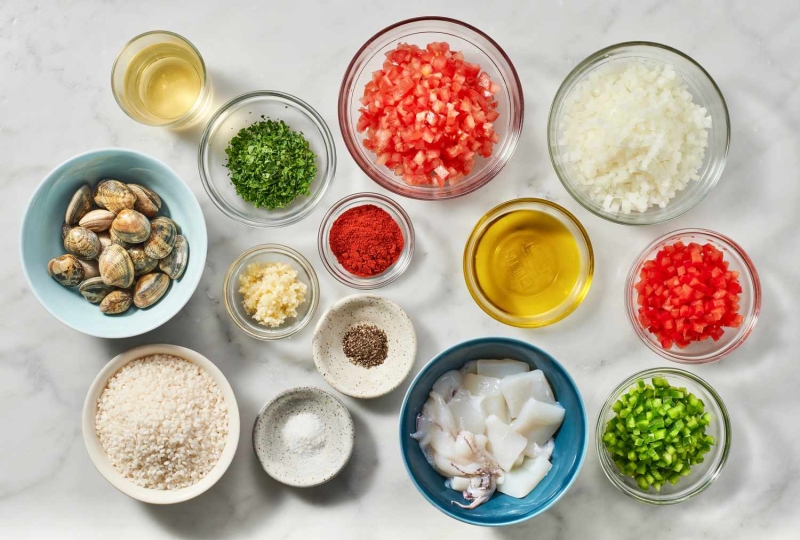
-
Heat the shrimp broth you made earlier in a medium saucepan and bring to a gentle simmer. Taste and season if needed. It should taste pleasantly seasoned. Cover the pan to prevent excess evaporation.

-
For the sofrito base, using a 12-inch shallow pan such as a skillet or paella over medium heat, heat 2 tablespoons of the oil and sauté the onion with a pinch of salt until translucent, about 5 minutes.
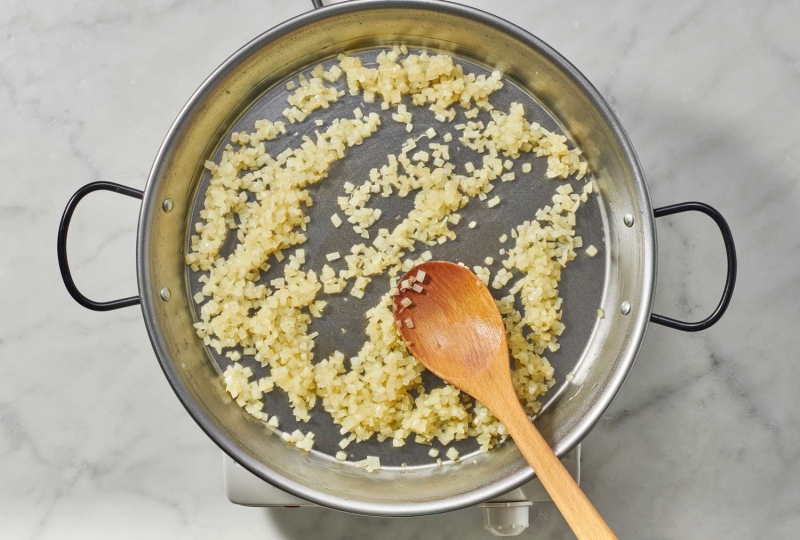
-
Add the red and green bell pepper and cook until soft, 7 to 8 minutes. Add the garlic and cook until it releases its aroma, 1 to 2 minutes.

-
Add the tomatoes, pimentón, salt, and pepper and cook down until all liquid from the tomatoes has evaporated, 5 to 8 minutes. Be sure to scrape the bottom of the pan well during this process.
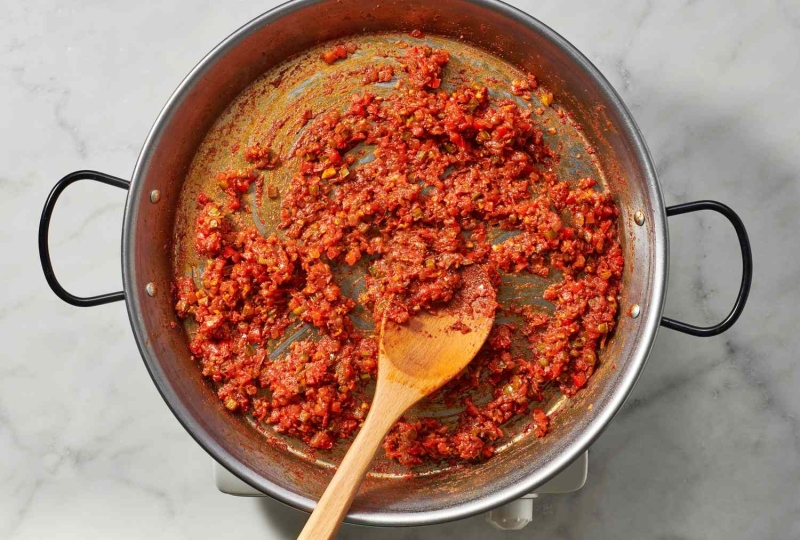
-
Transfer the sofrito to a bowl, scraping up as much of the browned bits on the bottom of the pan as possible. Clean the pan and return it to medium heat.
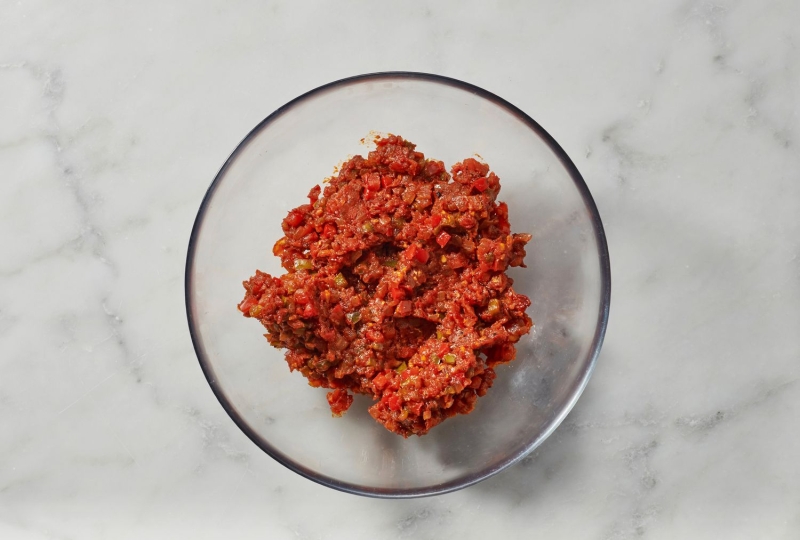
-
Add the remaining 2 tablespoons of olive oil to the pan, let the oil heat until shimmering, and add the cuttlefish. Sauté until the cuttlefish turn bright white, 3 to 5 minutes.
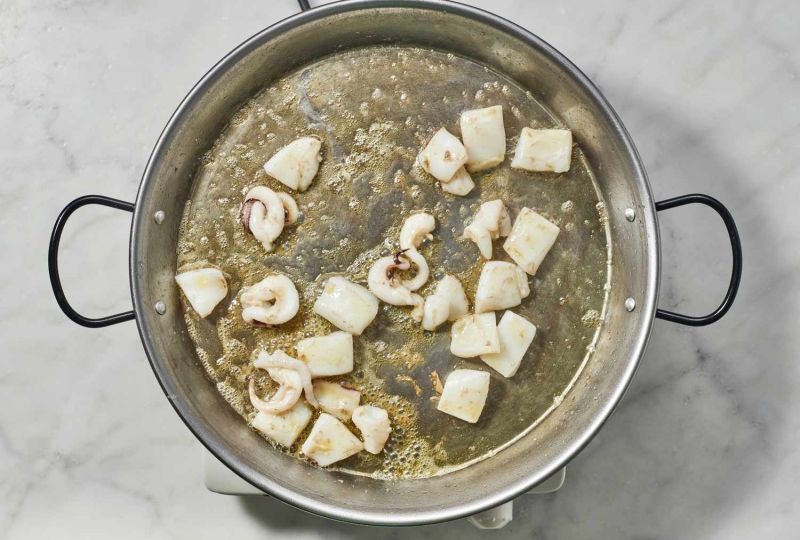
-
Add the sofrito back to the pan and stir.

-
Add the rice and stir well; give the rice 2 to 3 minutes to “toast” a little. You can tell it is toasted when it is white in the center with translucent edges. This is an important step in making paella and developing the flavor.
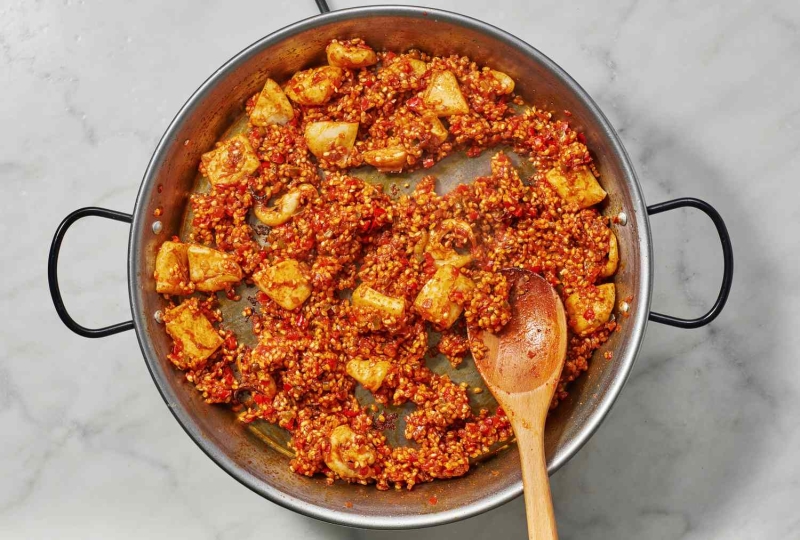
-
Add 1 3/4 cups of the hot broth to the pan. It will boil in the pan immediately. Give it a gentle stir making sure you are scraping the bottom. You should have some broth left in case you need to add more later. Taste a little of the broth after stirring it into the rice to make sure your paella will be well seasoned. Stir in more salt and pepper if needed.
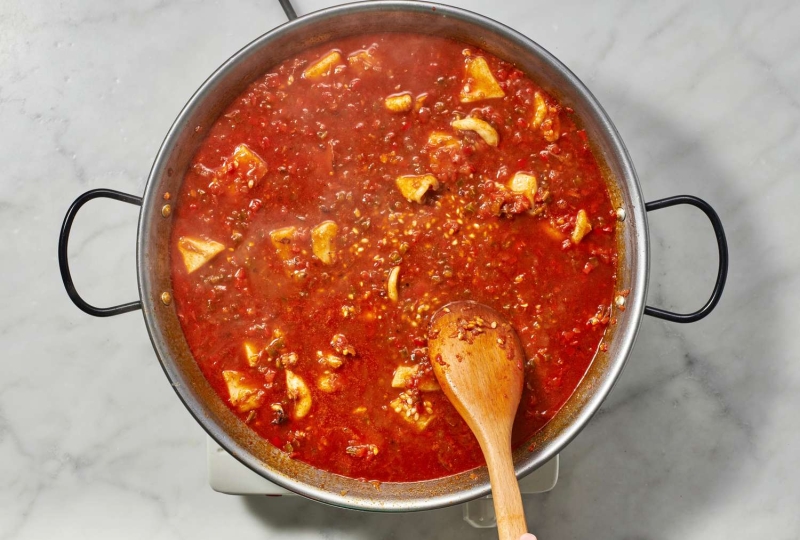
-
Bring the paella to a rolling boil. Turn down the burner to medium-low heat and cook the paella on the stovetop, covered, for 10 minutes.
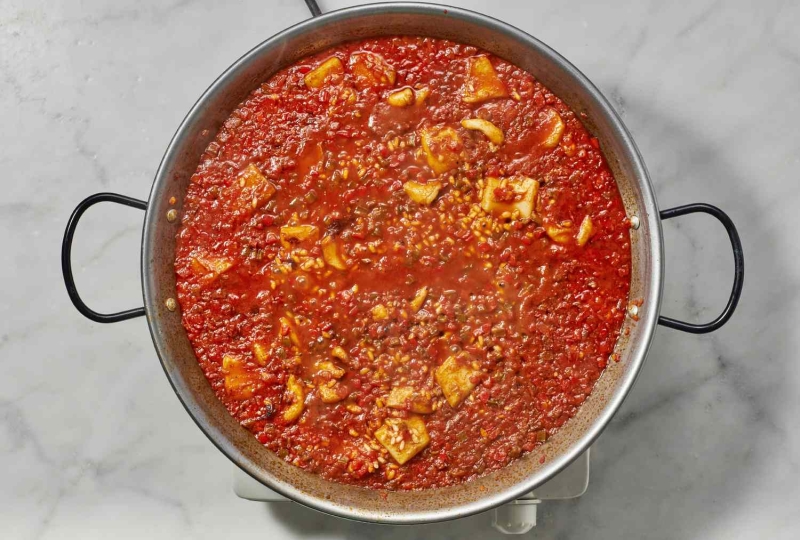
-
Arrange the reserved shrimp on top of the paella and cover the pan again. Continue to cook until the liquid is absorbed, the rice is cooked all the way, and the shrimp are bright pink, 5 to 8 minutes more.
If your rice has absorbed all the broth but is not yet tender, add 1/4 cup more hot broth evenly over the paella and continue to cook until the rice is done.
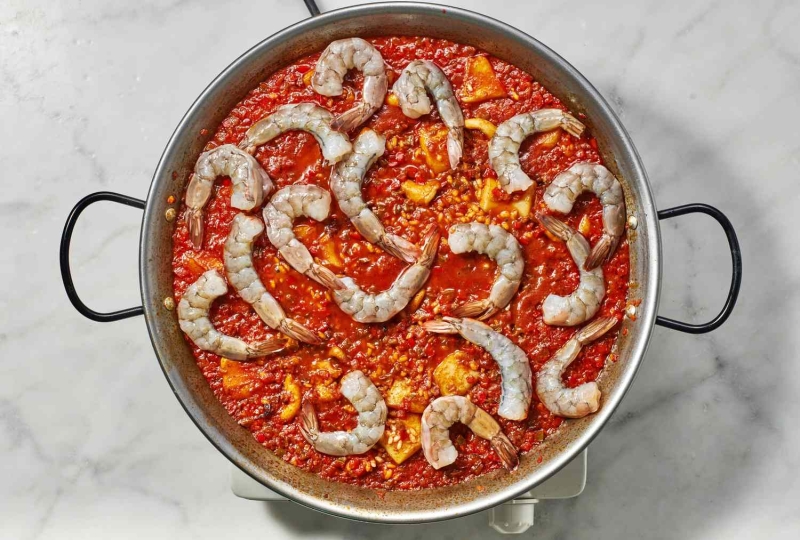
-
Uncover the pan and increase the heat to medium-high for a few minutes to make the socarrat.
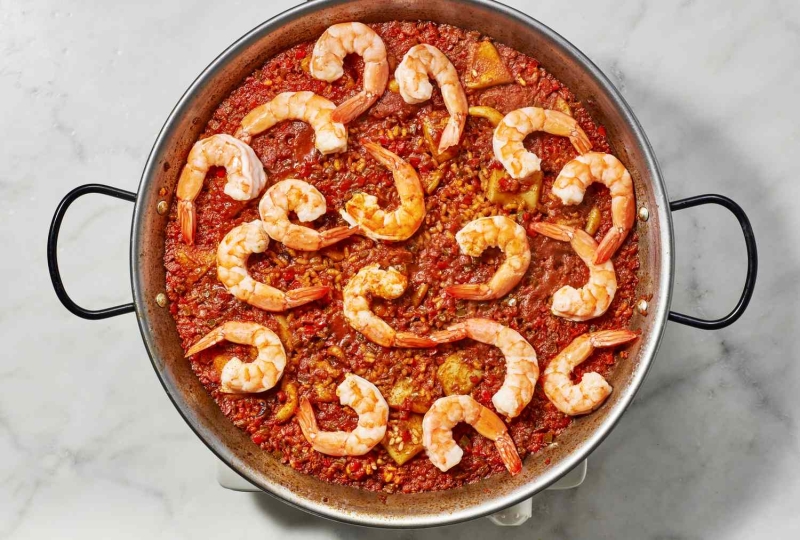
-
Once the socarrat has formed, take the pan off the heat, loosely cover the paella with foil, and let sit for 10 minutes.

-
While the paella is resting, in a large saucepan combine the white wine, 1 cup water, and the reserved parsley stems. Cover the pot and bring to a boil.
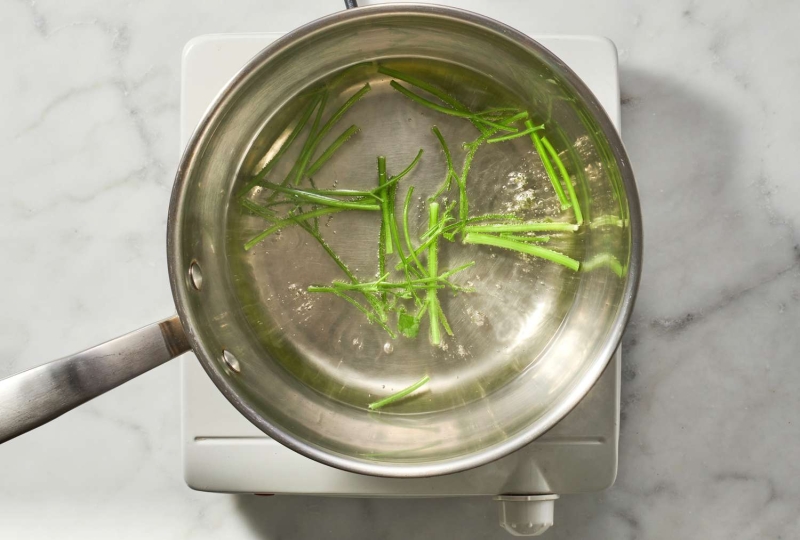
-
Add the clams and cover to steam until clams have opened, 5 to 7 minutes. Shake the pan occasionally while steaming. Any clams that did not open can be cooked a few minutes longer to coax them open.
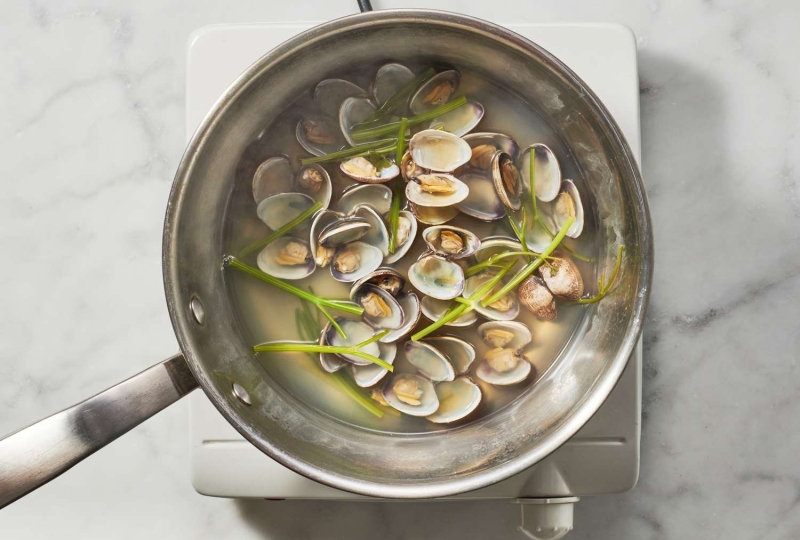
-
To serve, arrange the clams on top of the paella and sprinkle the paella with the parsley. Make sure you scrape the bottom of the pan to get some of the socarrat in every serving. Pass around the alioli.
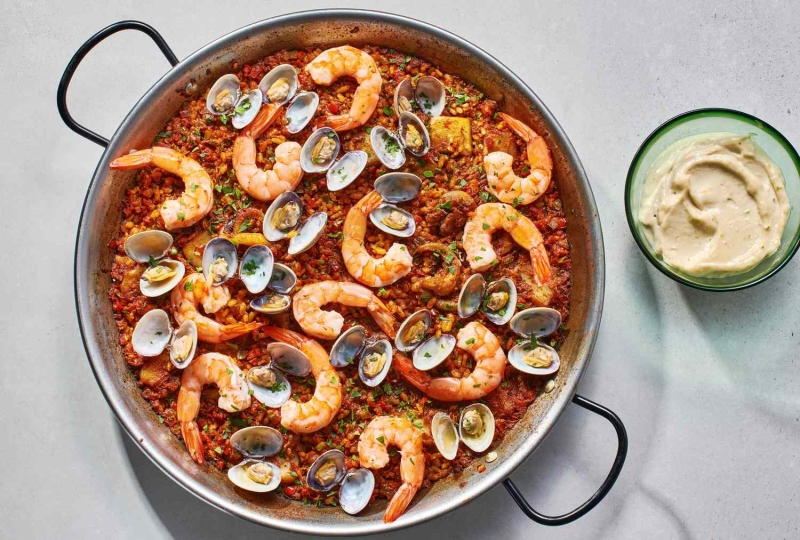
Raw Egg Warning
Consuming raw and lightly-cooked eggs poses a risk for food-borne illness.
How to Store
You can refrigerate leftovers in an airtight container for up to 3 days. It can easily be heated up with a splash of water in a covered bowl in the microwave. Or quickly sauté it with olive oil in a skillet.
Recipe Variations
- Swap in Different Proteins: The paella possibilities are endless. You can vary the protein used, but use the same method of cooking your sofrito, have a well-made broth on hand (use a broth that goes with the protein you use), and use Bomba rice. One of my household favorites is pork chop arroz and it uses the exact same method but I cut the pork chop in chunks, and I add the bone as well for flavor. It’s delicious.
- Cook the paella in the oven instead of the stovetop. Preheat the oven to 450 F. Once the rice and broth are added to the pan and the broth comes to a rolling boil, place the paella, uncovered, in the oven. Cook for 15 minutes, then place the shrimp and clams on top and return to the oven for 5 minutes more or until the clams open and the shrimp are bright pink. Oven-cooked paella has a higher rate of evaporation than stovetop paella, so if the paella looks dry when you add the shrimp and clams, pour 1/4 cup more broth evenly over the top of the paella. After the shellfish are cooked, transfer the paella to the stovetop over medium-high heat for a few minutes to create the socarrat.
| Nutrition Facts | |
|---|---|
| Servings: 4 | |
| Amount per serving | |
| Calories | 815 |
| % Daily Value* | |
| Total Fat 55g | 70% |
| Saturated Fat 7g | 34% |
| Cholesterol 271mg | 90% |
| Sodium 1814mg | 79% |
| Total Carbohydrate 41g | 15% |
| Dietary Fiber 6g | 21% |
| Total Sugars 9g | |
| Protein 39g | |
| Vitamin C 101mg | 505% |
| Calcium 249mg | 19% |
| Iron 8mg | 46% |
| Potassium 1163mg | 25% |
| *The % Daily Value (DV) tells you how much a nutrient in a food serving contributes to a daily diet. 2,000 calories a day is used for general nutrition advice. | |
